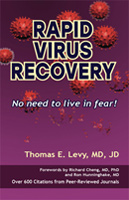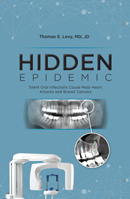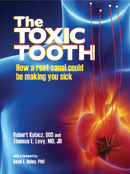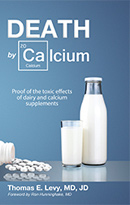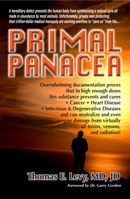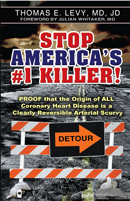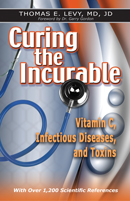Curing Polio with Magnesium: The tip of the iceberg?
05/31/2019 by Dr. Thomas Levy(OMNS May 31 2019) While magnesium remains greatly underutilized in the treatment of a wide range of medical conditions, it is gradually becoming a more common nonspecific positive "health tonic" added to an increasing number of intravenous infusions given around the world. Literally, greater than 99% of magnesium is contained inside the cells of the body, and getting as much magnesium to accumulate inside the cells over time is a highly desirable goal, as the vast majority of adults are depleted in their cells and particularly the mitochondria even when serum magnesium levels are in the normal range. Magnesium administration is only really potentially toxic in the context of renal failure, excessive and/or rapid intravenous infusion, and when magnesium cathartics stay in the bowels for days without being eliminated, such as is seen in many nursing home residents. It has also been found to be problematic in persons with myasthenia gravis and severe bradycardia.
Oxidative Stress
Diseases share the common denominator of increased intracellular oxidative stress in the affected cells and tissues. The degree to which this oxidative stress can be lessened and maintained in that state determines the efficacy of a treatment protocol. Toxins are pro-oxidants, and all disease-causing agents ultimately cause an increased pro-oxidant, or toxic, impact in order to inflict their damage. All infectious diseases do their damage by ramping up oxidative stress throughout the body, as virtually everything associated with or part of the infection progression increases the presence of pro-oxidant pathogen-related toxins. This includes exotoxins, endotoxins, cellular intrusion by viruses, and all of the pro-oxidant metabolites that result from an evolving infection, including a large amount of free iron as pathogens either frankly rupture or are gradually metabolized and processed. Really, except for the possible space-occupying characteristics of some infections (like focused oxidation that eventually erodes into a blood vessel with hemorrhagic and even fatal consequences), an infection only incapacitates to the degree that it consumes the antioxidant capacity of the body and increases body-wide oxidative stress. To express it slightly differently but very precisely, disease IS increased oxidation. The more biomolecules are oxidized (and relatively or completely functionally inactivated as a result), the more manifest the disease.
Magnesium and Vitamin C
Especially in acute infectious diseases, typically viral, serum vitamin C levels can drop to extremely low levels, and they can even become immeasurable in the urine. Magnesium levels typically decline in concert with such a vitamin C decline. There appears to be a strong therapeutic synergy between vitamin C and magnesium in normalizing elevated intracellular oxidative stress and in resolving either an acute infection or lessening the pathology of a chronic disease. When such oxidative stress can be reduced to normal, physiological levels, intracellular physiology normalizes, and the cell can be essentially regarded as cured, whether it was an infection or another toxin source that elevated the intracellular oxidative stress in the first place.
Magnesium increases the phagocytic capacity of the scavenging white blood cells in combatting infections, and vitamin C can attack pathogens directly via up regulation of the Fenton reaction inside the cells, increasing their internal oxidative stress to the point of pathogen rupture (Vilchèze et al., 2013; Levy, 2013). These anti-pathogen mechanisms can be very synergistic in treating infectious diseases. Furthermore, vitamin C enhances the capacity of all of the scavenger immune cells by concentrating inside them and allowing them to supply a greater immediate antioxidant delivery when the natural immune response summons them to areas of focal infection and inflammation that are always acutely and severely depleted of antioxidant capacity. However, a review of some older literature reveals, somewhat surprisingly, that magnesium chloride alone, given orally several times daily, has cured acute polio, even when significant paralysis had already developed (Neveu, 1961; Rodale, 1968). Dr. Frederick Klenner had also reported that high doses of vitamin C completely cured all of the 60 cases of polio that he saw in his practice. This result is likely achieved because both magnesium and vitamin C, as independent agents, can promptly normalize the pathology of increased intracellular oxidative stress seen in toxin exposures of any origin.
For many infections, it seems likely that either vitamin C or magnesium can be highly effective as monotherapies, since they both accomplish the desired goal of decreasing increased intracellular oxidative stress, but by different mechanisms. Vitamin C, as the premier antioxidant in the body, directly lowers intracellular oxidative stress the more it can be effectively concentrated inside the toxin-damaged cells. Magnesium, even though it is not a directly-acting antioxidant like vitamin C, promptly brings down elevated cytoplasmic calcium levels inside sick cells, which in turn promptly lowers intracellular oxidative stress as well. The following brief case reports demonstrate the incredible impact of magnesium chloride on 15 different cases of poliomyelitis, some extremely acute, and some seen several months after the onset of the infection.
Magnesium-Polio Case Reports from Dr. Auguste Pierre Neveu
- The first case of polio treated by Dr. Neveu was a four-year-old boy in September of 1943. Fairly rapid onset. The child was crying, would not eat, and he was unable to stand on his left leg. Dr. Neveu mixed 5 grams of magnesium chloride in 250 cc of water. 80 cc doses were given orally at 1 pm and again at 4 pm. At the time of the second dose, the state of leg paralysis was considered to be "complete." Another dose was given 3 hours later. The next morning both the paralysis and the fever that had been present were resolved. There was no return of symptoms. This represented a complete cure with less than 24 hours of receiving magnesium chloride treatment.
- Dr. Auguste Pierre Neveu treated his second case of polio two years later. He saw an 11-year-old boy with headache, discomfort in the neck and the back, and an inflamed throat with difficulty in swallowing his saliva. He reported that his legs had no feeling, and seemed as if they were made of wool, with a complete inability to stand up. He had upper arm pain, and his eyes were very sensitive to light. Rectal temperature was 102 degrees F. For this child, Dr. Neveu prepared a solution of magnesium chloride with 20 grams dissolved in a liter of water. The child had been stricken suddenly that morning and was receiving his first dose of magnesium chloride, 125 cc orally, early that afternoon, with follow-up doses every six hours. Evening temperature had increased to 103 degrees F. The next day morning temperature was 100.1 degrees F and evening temperature was 101 degrees F. The child had slept well the first night, all symptoms had generally lessened, and he was able to stand up when he awoke. He asked for food the second night. The following day (48 hours after onset of symptoms) morning temperature was 99.3 degrees F and evening temperature was 99.8 degrees F. Overall condition was clearly improved, and the magnesium dosing frequency was decreased to 125 cc every eight hours. The next day the child appeared to have been cured of his condition, although it was noted that he was still slightly sensitive to light. Dosing was continued at 125 cc every eight hours. On the next day (four days after being stricken) recovery was deemed complete, and magnesium therapy was discontinued. The following day showed a morning temperature of 98.6 degrees F and an evening temperature of 99.4 degrees F.
- The third case reported on by Dr. Neveu was a 47-year-old woman who presented with complete paralysis in the right lower leg and in the lower back. A complete cure was observed on the magnesium therapy, but it required 12 days of treatment.
- A 13-year-old boy had an abrupt onset of chills with shivering and headache. Temperature was 40 degrees C (104 degrees F). The next day the temperature was 38.8 degrees C, and there was severe pain in the head, neck, and back. His eyes could not tolerate light. The temperature went back up to 40.4 degrees C. The physician (not Dr. Neveu) told the boy's mother that he suspected the child contracted polio, and that he would check back in two days. The following morning the mother said all symptoms were even more severe. She had seen an article about Dr. Neveu and his magnesium therapy and convinced him to see her son at home. Dr. Neveu termed the child's condition a "swiftly progressing poliomyelitis," and he gave the child his first dose of 125 cc of the magnesium chloride solution (20 grams in one liter of water), to be repeated every six hours. Temperature was still 39.6 degrees C at that time. The following morning the head, neck, and back pain had subsided. Morning temperature was 37.1 degrees C and evening temperature was 37.8 degrees C. The child began to engage in normal activities. On the following day only two doses of the magnesium were taken, and slight head discomfort returned with a temperature back up to 38.2 degrees C. Three doses were taken the next day, and the following day the magnesium was discontinued with morning temperature of 37.2 degrees C and evening temperature of 37 degrees C. A complete cure had been achieved.
- 9-year-old boy with right lower leg paralysis. Completely cured by Dr. Neveu with one week of magnesium therapy.
- 13-year-old girl with stiffness in the back and lower limb nervous trembling. Magnesium therapy resulted in a rapid clinical response. The parents discontinued the magnesium, and Dr. Neveu later restarted it, but the child ended up keeping a paralysis of the extensor muscle of her left big toe, probably because of the interruption in the treatment.
- 20-year-old woman with a persistent headache that progressed to vomiting and a stiff neck and back. The family physician suspected polio. The pain became so severe that the patient threatened to commit suicide. After the first dose of magnesium given by Dr. Neveu, the woman had enough pain relief to allow her to sleep. A complete cure was realized with 12 days of magnesium therapy.
- 3-year-old girl who had been hospitalized for polio and was discharged to home with paralysis in both legs. Magnesium therapy was started a full 25 days after the polio was contracted. After two weeks of treatment, a great deal of leg mobility had returned. Following physical rehabilitation, she remained with a slight limp.
- 20-year-old male farmer who was already paralyzed in both legs and the right arm. Magnesium was started 32 days after the initial polio attack. He responded well, and he was able to walk with crutches after four months of treatment. Two years later he could walk with just the assistance of a cane.
- 19-year-old woman who first saw Dr. Neveu four months after the initial polio attack. Her left leg was not only paralyzed, it had also begun to atrophy. She was treated for 15 days with the magnesium and demonstrated marked improvement of the leg. She was eventually able to ride a bicycle and walk with a limp.
- 2-year-old girl who received magnesium treatment 17 days after the initial polio attack. When first seen she was unable to stand and could not move her right arm. While her legs regained completely normal function, her right shoulder remained paralyzed.
- 4-year-old girl with right arm and right leg paralysis who received magnesium treatment 10 days after the initial polio attack. She eventually had a dramatic return of arm and leg function, but with only roughly 60% of normal strength.
- 2 and 1/2-year-old boy started on magnesium therapy 10 days after diagnosis. The abdominal paralysis improved significantly after two days, and a complete recovery was seen after 21/2 months.
- 20-month-old male infant with polio diagnosed by spinal tap 12 days after onset of the clinical syndrome. His left foot was completely paralyzed, but he responded to magnesium well and was nearly normal after five months, but requiring the support of orthopedic shoes.
- 12-year-old girl who saw Dr. Neveu immediately after the onset of sore throat and stiff neck. Magnesium was started, but the stiffness increased and went down the spine initially. However, with continuation of the magnesium, the stiffness had resolved by the next morning. The sore throat was gone the following morning.
It is not clear at this time if all forms of magnesium would have the same level of clinical impact on polio as magnesium chloride. There is some evidence that the chloride plays a critical role along with the magnesium in the rapid resolution of the acute infection. This could be easily clarified by straightforward clinical studies. Nevertheless, this extremely simple magnesium chloride-water solution approach to polio would indicate a similarly positive response might well be seen in many or all of the acute viral afflictions (as has already been seen with vitamin C as a monotherapy). This could make an incredibly potent and cheap therapy available literally world-wide. Vitamin C is wonderful, but even it is expensive compared to magnesium chloride.
(Dr, Thomas E. Levy is board certified in internal medicine and cardiology. He is the author of several books, and an upcoming volume on magnesium. )
References
Klenner F (1949) The treatment of poliomyelitis and other virus diseases with vitamin C. Southern Medical Journal 111:209-214. PMID: 18147027, https://www.ncbi.nlm.nih.gov/pubmed/18147027
Vilchèze C, Hartman T, Weinrick B, Jacobs WR Jr. (2013) Mycobacterium tuberculosis is extraordinarily sensitive to killing by a vitamin C-induced Fenton reaction. Nat Commun. 4:1881. doi: 10.1038/ncomms2898. https://www.ncbi.nlm.nih.gov/pubmed/23695675 https://www.nature.com/articles/ncomms2898
Levy TE (2013) Vitamin C, Shingles, and Vaccination. Orthomolecular Medicine News Service. http://orthomolecular.org/resources/omns/v09n17.shtml
Neveu A (1961) Le Chlorure de Magnesium Dans L'Elevage: Traitment Cytophylactique des Maladies Infectieuses. Librairie Le Francois: Paris, France
See also: Neveu AP. (1958) Traitement cytophylactique des maladies infectieuses par le chlorure de magnésium, la poliomyélite. 3e édition. And:
Neveu A. (1968) Comment prévenir et guérir la poliomyélite. 5e édition. Traitement cytophylactique des maladies infectieuses par le chlorure de magnésium. And:
Dekopol B. (2018) Le Chlorure de Magnésium Histoire et Manuel Pratique : Traitement des maladies infectieuses chez l'homme et les animaux. 4e édition.
Rapp F, Butel J, Wallis (1965) Protection of measles virus by sulfate ions against thermal inactivation. Journal of Bacteriology 90:132-135. PMID: 16562007, https://www.ncbi.nlm.nih.gov/m/pubmed/16562007/
Rodale J (with Taub H) (1968) Magnesium, the Nutrient that could Change Your Life. New York, NY: Pyramid Publications, Inc.
To learn more
Levy T (2011) Primal Panacea. Henderson, NV: MedFox Publishing
Levy T (2013) Death by Calcium: Proof of the toxic effects of dairy and calcium supplements. Henderson, NV: MedFox Publishing
Orthomolecular Medicine News Service, (2010) About "Objections" to Vitamin C Therapy. http://www.orthomolecular.org/resources/omns/v06n24.shtml
Saul AW (2013) Ascorbic Acid Vitamin C: What's the Real Story? http://orthomolecular.org/resources/omns/v09n27.shtml
Dean C (2017) Magnesium. http://orthomolecular.org/resources/omns/v13n22.shtml
More Orthomolecular articles:
11/11/2010 | Vitamin C And The Law
02/14/2012 | Vitamin C Prevents Vaccination Side Effects; Increases Effectiveness
08/27/2013 | Vitamin C, Shingles, and Vaccination
09/03/2014 | The Clinical Impact of Vitamin C:
My Personal Experiences as a Physician
05/31/2019 | Curing Polio with Magnesium: The tip of the iceberg?
10/25/2019 | Reboot Your Gut: Optimizing Health and Preventing Infectious Disease
01/29/2020 | Vaccinations, Vitamin C, Politics, and the Law
07/18/2020 | COVID-19: How can I cure thee? Let me count the ways
08/21/2020 | Curing Viruses with Hydrogen Peroxide: Can a simple therapy stop the pandemic?
05/10/2021 | Hydrogen Peroxide Nebulization and COVID Resolution: Impressive Anecdotal Results
06/21/2021 | Resolving Long-Haul COVID and Vaccine Toxicity: Neutralizing the Spike Protein
10/18/2021 | Canceling the Spike Protein: Striking Visual Evidence
12/11/2021 | Vitamin C and Cortisol: Synergistic Infection and Toxin Defense
02/01/2022 | How COVID Helped Me Regain Good Health
05/11/2022 | The Restoration of Vitamin C Synthesis in Humans
06/01/2022 | Monkeypox Infection - To Fear or Not to Fear?
09/08/2022 | Atherosclerosis is a Non-Healing Wound
01/05/2023 | Myocarditis: Once Rare, Now Common
02/04/2023 | Resolving Colds to Advanced COVID with Methylene Blue
03/10/2023 | Resolving Persistent Spike Protein Syndrome
07/31/2023 | The Toxic Nutrient Triad
09/27/2023 | Persistent Spike Protein Syndrome: Rapid Resolution with Ultraviolet Blood Irradiation
10/12/2023 | Schizophrenia Is Chronic Encephalitis...and Niacin Cures It
11/03/2023 | Heart Failure or Therapy Failure? Toxins Cause Cardiomyopathy
12/17/2023 | Root Canals Cause Breast Cancer-Frequently
Article also available at Orthomolecular Medicine News Service
OMNS free subscription link http://orthomolecular.org/subscribe.html
OMNS archive link http://orthomolecular.org/resources/omns/index.shtml


